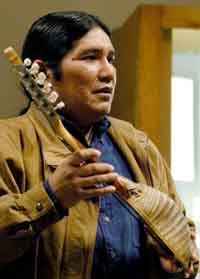USU students unveil new anthropology exhibit
The deep heartbeat-like rhythms pound and soar while hollow, wooden flutes add their haunting melodies to the low, soulful groan of a didgeridoo. The music can be felt in the very depths of the soul. It’s no wonder this music moved civilizations to be created and cultures to thrive.
Five Utah State University students created an innovative, traveling exhibit that will be shown to junior high and high school students around Utah. The exhibit focuses on the culture behind music.
The current display was not the idea the exhibitors were presented with. When the project was first brought up to the anthropology department a year ago, the general idea was to get children interested in anthropology. The students were told to put together “maybe something about baskets,” said Bonnie Pitblado, professor of anthropology at USU.
After a few weeks, they decided music would be better.
“Despite language barriers and cultural differences, everyone can understand music,” said Stacie Palmer, a senior majoring in art who also designed the exhibit.
Exhibit curator, Laura Petersen, said they had to borrow the didgeridoo for the Australian exhibit, the drums were owned by the USU anthropology department, and the rest was purchased.
“There was a security issue. The instruments had to be realistic but also easy to replace if they were stolen,” Petersen said.
Kirk Eriksen, a senior majoring in anthropology, developed the sound system and the 30-second sound bytes that were narrowed down from thousands of musical pieces available.
Michael Brogan, a senior majoring in history, researched the different cultures and how they used music.
Petersen said they included things in the exhibit that make the relationships between cultures easy for children to see.
“For example, in Uganda the drum is like the emergency broadcast system,” she said.
Alison Fox, a senior majoring in anthropology, did much of the public relations work. She also did the finishing touches and researched what teachers would like to see in this type of exhibit.
Anita Sant, a senior majoring in anthropology, put together education packets that teachers can go through with their students after they see the exhibit.
Petersen said she was really impressed with the hard work and dedication. It took a full calendar year to complete this project, and the enthusiasm for the project was kept throughout the year. Even during finals week, they logged many hours just trying to get it finished in time.
“We needed something that would hold [the interest of] children of some various age groups,” Palmer said. “That was very hard to find.”
After the topic was decided, the students had to decide the countries they were going to do and what instruments to include. They narrowed it down to Australia, Uganda and The Andes.
The Australian part of the exhibit includes a didgeridoo, a wind instrument that sounds amazingly like a Star Wars light saber; a bull-roarer, which is a thin, oval-shaped piece of wood about five inches long attached to a string that is swung around the head and makes a distinct whooping sound; and click sticks, two sticks that beat against each other.
A ngoma, or talking drum, was included in the Uganda exhibit. The drum is used to beat out an identifying rhythm, like an audible area code, to other villages. The thumb piano and a marimba-like instrument called amadina were also included.
The Andes instruments included the siku panpipes, quena flute and chajchas rattles, which are goat or sheep hooves worn around the ankles and wrists.
The exhibit was designed for one teacher to use and transport. Teaching packets and worksheets accompany the exhibit.
Petersen said, “I hope that this will become part of curriculum in schools, I hope that it will be something useful to all teachers and not just history, art and music teachers.”
–kassrobison@cc.usu.edu

Antonio Arce explains the origin of the charango — a traditional instrument in parts of South America. (Photo by Ryan Talbot)

